O Vertigo Danse of Montreal and the Société de Musique Contemporaine du Québec perform Ginette Laurin’s La Vie Qui Bat and Steve Reich’s Drumming at Jacob’s Pillow.
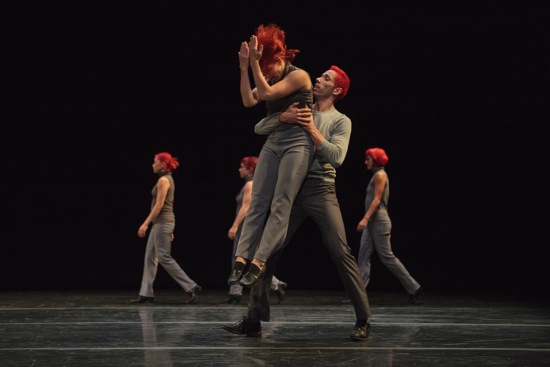
Ginette Laurin’s La Vie Qui Bat. Foreground: Caroline Laurin-Beaucage and Louis-Elyan Martin. At back, L to R: Wen-Shuan Hang, Audrey Bergeron, and Geneviève Boulet. Photo: Karli Cadel.
There are two performances happening simultaneously on the stage of Jacob’s Pillow’s Ted Shawn Theatre, but I can only see one of them and a tantalizing smidgen of the other. The one I can see is Ginette Laurin’s La Vie Qui Bat (The Beat of Life) performed by nine virtuosic members of her Montreal-based company, O Vertigo. What I can’t see is the dance of arms and bodies belonging to members of the Ensemble de la SMCQ, which consists of the six musicians of Sixtrum—The HeART of Percussion, three additional percussionists, a flautist, and two female singers. They are playing Steve Reich’s great 1971 Drumming, and the patterned swing and fall of mallets swing makes the score visible. For those who can see them.
Ideally, La Vie Qui Bat would be presented on a stage deep enough to allow the musicians to be placed behind the dance. In the Ted Shawn Theatre, they play from just offstage right, which means that those spectators seated on the opposite side of the theater can see them pretty well, while others see them less well, and some hardly at all.
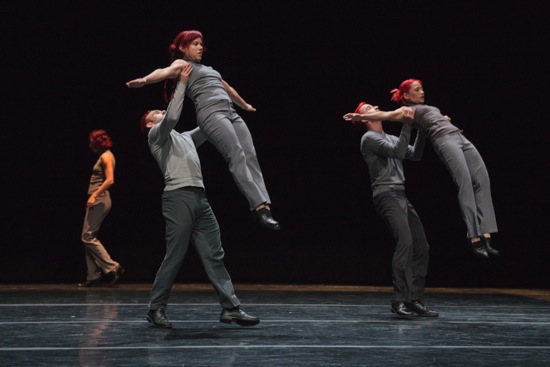
(L to R) James Phillips lifts Audrey Bergeron, Louis-Elyan Martin lifts Wen-Shuan Yang. Geneviève Boulet at back. Photo: Karli Cadel
We can, of course, hear them, which is the most important thing. There’s something magical about this score, with its unstopping pulse and its emphasis on repetition. Say three musicians, gradually joining to playing the same short passage on tuned bongo drums, slip out of synch with one another; as the sound becomes denser, submerged motifs emerge. You can choose to follow any one of them; you can practically hum it. So imagine the intricate, thrumming web of sound that can then be shaped by three marimbas and two female voices (that hardly sound like voices), then by three glockenspiels plus a piccolo, finally by all the instruments. It’s hard to believe that all of Drumming is built on one basic rhythmic pattern. As Reich has written, “This pattern undergoes changes of phase position, pitch, and timbre, but all the performers play this pattern, or some part of it, throughout the entire piece.”
I saw the dance that Laura Dean set to this music in 1975 and the first half of Ann Teresa De Keersmaeker’s 1998 choreography for it in 2008. The revival of Laurin’s 1999 work is as different from the previous two as they are from each other. Dean’s piece, for instance, involved strenuous and bouncy footwork, like that of a Slavic folk dance, and spinning. Laurin makes it clear that her nine dancers are members of a highly althletic tribe. They all wear trim, casual shades-of-gray (mostly) attire and may remove or add pants and shirts. All have their hair dyed a practically fluorescent red. They are dancing “to” the music, in a sense, but not dealing with its every rhythmic complication. Instead, Reich’s patterns seem to function as a three-dimensional web that they fit themselves into where they can. Their basic rhythms seem as even as the music’s underlying pulse, although almost never as fast. And it doesn’t seem to me that their “tone” changes when, for example, the higher, jingling glockenspiels replace the deeper marimbas.
Laurin handles the kinship between music and dance in various structural ways. For instance, even before the first drummer begins, Geneviève Boulet starts to travel along a path of light at the front of the stage. She covers ground at a fairly slow pace—undulating her torso, putting a hand to her ear as if listening a sea shell, pointing a finger. As others enter and begin their own patterns, she continues her voyage, turning left onto a path leading upstage (pausing to open her mouth as if to exhale or hiss), and then turning left again to travel across the back of the stage, and then toward the audience. Others sometimes enter that border, treating it as a sort of waiting zone, even when the lighting is bright on the rest of the stage (lighting design by Axel Morgenthaler, lighting adaptation and direction by François Marceau).
When I saw Laurin’s choreography in the 1980s, I found it very daring physically—strenuous and a bit wild. The name, O Vertigo, suggested her love affair with disequilibrium, leaning forward, say, at the edge of a cliff. Her choreography is athletic still, but more controlled—with every risk counterbalanced. As dancers enter and leave, they form temporary partnerships. Men hoist women, lay them athwart their thighs. Men tangle with men (notably in a duet by Louis-Elyan Martin and James Phillips). Women lift men. Sometimes two identical duets happen at the same time; once a third duet mimics the music by being briefly out of phase with the other two. One engrossing duet is performed by Wen-Shuan Yang and Phillips. It’s almost as if he’s assisting her to perform movements she could do without his help. She, in turn, listens to his ankle and handles him as if fixing him up for some about-to-happen occasion.
Sometimes the events become more reckless. People run at other people and are lifted. Then they run to new partners. They form and un-form circles. Like the music, the texture of the dance thickens and thins. Occasionally dancers move in slow motion. But at times, gestures and poses predominate, such as pointing a finger, crossing one’s arms over one’s chest, stroking one’s body.
The performers move with fervor and heroic intensity. Those not already named are Audrey Bergeron, David Campbell, Marianne Gignac-Girard, Caroline Laurin-Beaucage, and Robert Meilleur. They deserve the applause and the cheers that they incite.
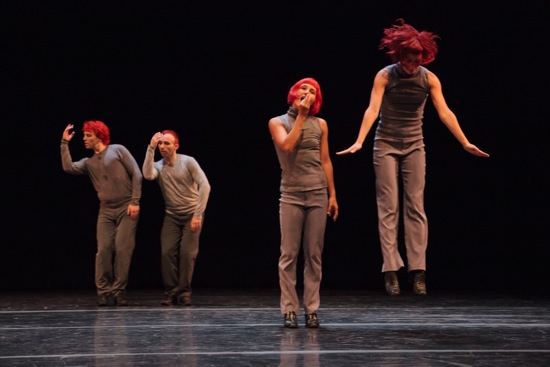
(L to R): David Campbell, James Phillips, Marianne Gignac-Girard, Geneviéve Boulet. Photo: Karli Cadel
La Vie Qui Bat is ingenious and intriguing, but it doesn’t match Reich’s score in at least one respect. You can imagine these people performing small rituals and demanding tasks needed for survival. The jubilation and the singing-ness of the music that influences their patterns aren’t part of their lives.

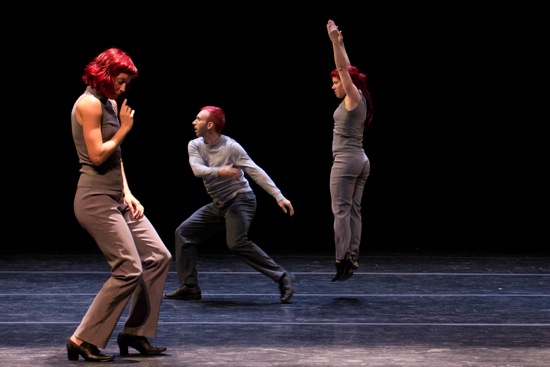
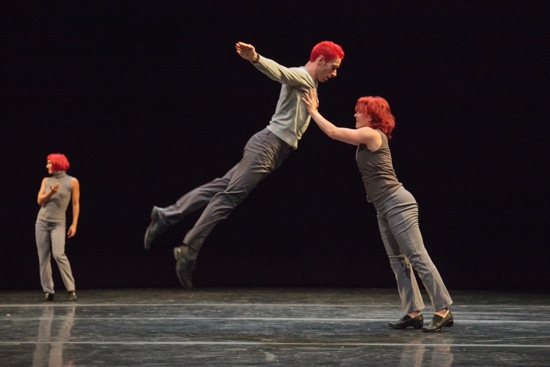
When Nederlands Dans Theater performed Kylian’s Falling Angels in Seattle, they had the musicians in the aisles, which gave us a great view of the physicality of the work.